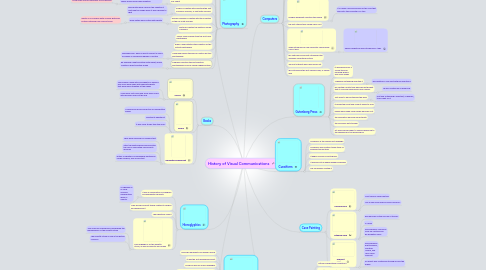
1. Hieroglyphics
1.1. It was a combination of logogram and alphabetic elements
1.1.1. A logogram is is visual symbols representing ideas or objects
1.2. They would be about things relating to religion and government
1.3. The Egyptians used it
1.4. This language is on the Rosetta Stone, as well as Demotic and Greek
1.4.1. Jean Francois Champollion deciphered the hieroglyphics on the Rosetta Stone
1.4.2. The Rosetta Stone is now in the British Museum
2. Books
2.1. Scrolls
2.1.1. Some where made with long sheets of papyrus and some were made with seperate sheets that were glued together at the edges
2.1.2. Some were just rolled and some were rolled with wooden rollers at the end
2.2. Codex
2.2.1. Covered and bound collection of handwritten pages
2.2.2. Christianty adopted it
2.2.3. It was more sturdy than the scroll
2.3. Illuminated Manuscript
2.3.1. They were reserved for religious text
2.3.2. After the printing press was invented the use of illuminated manuscripts declined
2.3.3. initials of chapters or paragraphs paintings in margin borders, and around text
3. Phonetic Alphabet
3.1. One sign represents one spoken sound
3.2. it was the first widespread script
3.3. could be used inn many languages
3.4. the Phonetic alphabet spread through trade with parts of North Africa and Europe
3.5. Serif
3.5.1. finishing off strokes
4. Photography
4.1. Camera Obscura
4.1.1. used to observe light
4.1.2. a camera obscura room was a darkened room with a convex lens inserted into the wall
4.1.3. in the 17th and 18th centuries it shrunk into a portable box
4.2. Photography originated from the Greek words for light and writing
4.3. Joseph Niepce created the first successful photograph in 1827
4.4. the Calotype process was invented by William Fox Talbot
4.4.1. the subject was exposed onto a light sensitive paper producing a paper negative
4.4.1.1. could make as may duplicates as you wanted
4.5. Archer is created with inventing the Wet Collodion Process, or Wet Plate Process
4.5.1. glass plates were used for the negative it captured the image when it was exposed to light
4.6. Richard Maddox is created with the invention of the Dry Plate Process
4.6.1. glass plates were coated with gelatin
4.6.1.1. gelatin is a colorless water-soluble glutinous protein obtained from animal tissue
4.7. Eastman created the Eastman Kodak Company
4.8. James Clerk Maxwell took the first color photograph
4.9. Edwin Land patented the invention of the instant photograph
4.10. Muybridge paved the way for motion picture photography
4.10.1. zoopraxiscope- device used to project a series of images in successive phases of motion
4.11. Daguerre invented the first practical photographic process called Daguerreotype
4.11.1. he exposed a light sensitive metal sheet, which created a direct positive image
5. Cuneiform
5.1. Cuneiform is the worlds first language
5.2. Cuneiform was created t keep track of business transactions
5.3. It began a series of pictograms
5.4. It evolved into a wedge shaped language
5.5. The Sumerians created it
6. Cave Painting
6.1. Lascaux Cave
6.1.1. Most famous cave painting
6.1.2. Has a man made replica called Lascaux 2
6.2. Altamira Cave
6.2.1. Red because of the red clay in the soil
6.2.2. In Spain
6.2.3. Discovered by Marcelino Sanz de Sautuda and his daughter Maria
6.3. Chauvet Pont d'arc
6.3.1. Discovered by Eliette Brunell, Christian Hillaire, and Jean Marie Chauvet
6.3.2. 3D effect was created by etching around the edges
7. Gutenberg Press
7.1. it developed from a screw-type for pressing grapes and olives seeds
7.2. Johannes Gutenberg invented it
7.2.1. he invested in John Fust with his inventions
7.3. he created a metal type because he thought that it could be reproduced more quickly
7.3.1. he also created an oil based ink
7.4. first book to be printed was the bible
7.4.1. Fust and Gutenberg's assistant, Schoeffer, took credit for it
7.5. it perfected script and made it easier to read
7.6. books were made more rapidly because of it
7.7. the population became more literate
7.8. the economy got stronger
7.9. art and science began to flourish which led to the beginning of the Renaissance
8. Linotype Machine
8.1. Ottmar Mergenthaler invented it
8.2. he got the idea from the typewriter
8.3. it allowed it to be set mechanically rather than by hand
8.4. the first Linotype was installed in the New York Tribune in 1886
8.5. the keyboard had 90 characters, there was no shift key, uppercase and lowercase were seperate keys, arrangement of keys was based upon letter frequency
8.6. it changed the newspaper industry because i made it possible for a small number of workers to set type for more pages on a daily basis
9. Computers
9.1. Konrad Zuse invented the first freely programmable computer
9.2. the first commercial computer was Univac
9.2.1. John Preseper and John Mauchly designed it
9.2.2. stands for Universal Automatic Computer
9.3. the first high level programming language was Fortan
9.4. first computer game was spacewar
9.5. Douglas Engelbart invented the mouse
9.5.1. it is called a mouse because of the cord that goes into the computer is a "tail"
9.6. the first internet was called ARPA Net
9.7. Apple introduced a new computer called Apple Lisa in 1983
9.7.1. Apple Machintosh was introduced in 1984
